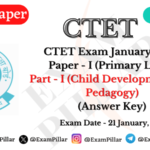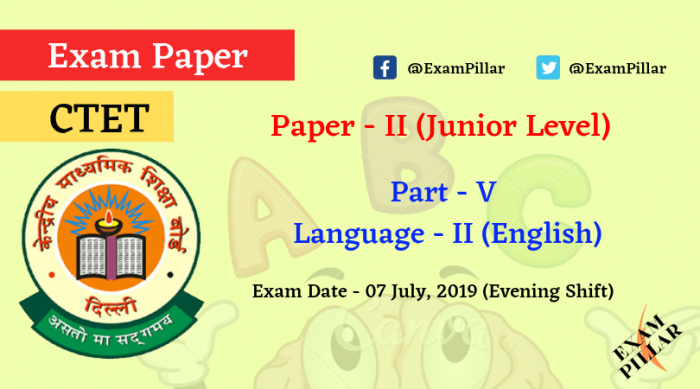CBSE conducted the CTET (Central Teacher Eligibility Test) Exam Paper held on 08th December 2019 Morning Shift. Here The CTET Paper – I, Part – II (Mathematics) in Hindi Solved Question Paper. CTET December 2019 Answer Key.
CTET (Central Teachers Eligibility Test)
Paper – I Primary Level (Class 1 to Class 5)
परीक्षा (Exam) – CTET Paper I Primary Level (Class I to V)
भाग (Part) – Part – II गणित (Mathematics)
परीक्षा आयोजक (Organized) – CBSE
कुल प्रश्न (Number of Question) – 30
Paper Set – C
परीक्षा तिथि (Exam Date) – 08th December 2019
CTET Exam December 2019 Paper – 1 (Primary Level)
Part – II गणित (Mathematics)
31. निम्नलिखित में से किसे संरचनात्मक (रचनावादी) गणितीय कक्षा कक्ष का लक्षण नहीं माना जा सकता है?
(1) प्राथमिक स्तर पर आकलन के लिए विषयपरक प्रकार की परीक्षा का उपयोग किया जाता है।
(2) गणित और दूसरे पाठ्येतर क्षेत्रों के बीच के संबंधों को उजागर किया जाता है।
(3) गणित के अधिगम में भाषा और संवादों की भूमिका पर उचित ध्यान दिया जाता है।
(4) अध्यापक स्वीकार करता है कि दी गई अन्योन्य क्रिया को विभिन्न विद्यार्थी अलग-अलग प्रकार से समझ सकते हैं
Show Answer/Hide
32. निम्नलिखित में से कौन से कथन की सहमति गणित के संरचनात्मक (रचनावादी दृष्टिकोण) से की जा सकती है?
(1) गणित पूर्णतया विषयपरक है।
(2) मानसदर्शन गणित का महत्त्वपूर्ण पहलू
(3) गणित तथ्यों को सीखने के बारे में है।
(4) गणितज्ञों से सच्चाई का आविष्कार अपेक्षित होना चाहिए।
Show Answer/Hide
33. निम्नलिखित में से कौन सा क्रियाकलाप बच्चों में त्रिविम समझ को विकसित करने के लिए अधिक उपयुक्त है ?
(1) चंद्रमा के उदय होने का समय लिखना।
(2) संख्याओं को संख्या रेखा पर निरूपित – करना।
(3) बोतल के ऊपरी दृश्य को चित्रित करना ।
(4) मानचित्र पर शहरों का स्थान निर्धारण करना।
Show Answer/Hide
34. गणित के अधिगम के संबंध में निम्नलिखित में से क्या सही नहीं है ?
(1) विद्यार्थियों की सामाजिक-आर्थिक पृष्ठभूमि का गणित के निष्पादन पर असर होता है।
(2) विद्यालय में दिए जाने वाले निर्देशों की भाषा का असर बच्चे के गणित के प्रदर्शन पर हो सकता है।
(3) गणित में उत्कृष्ट प्रदर्शन की प्रतिभा स्वाभाविक होती है।
(4) अध्यापक के सीखने वालों के प्रति विचारों का अधिगम परिणामों पर प्रभावशाली असर होता है।
Show Answer/Hide
35. निम्नलिखित शाब्दिक समस्या के प्रकार को पहचानिए।
मेरे पास 6 पेंसिल है। मनीष के पास मेरे से दो अधिक है । मनीष के पास कितनी पेंसिल हैं?
(1) व्यवकलित जमा
(2) व्यवकलित घटा
(3) तुलनात्मक जमा
(4) तुलनात्मक घटा
Show Answer/Hide
36. हिंदू-अरबी गणना-प्रणाली के लिए निम्नलिखित में से कौन सा सही नहीं है?
(1) इसमें आधार 2 की प्रणाली का पालन किया जाता है।
(2) यह गुणनात्मक प्रकृति का है।
(3) एक संख्या में अंक की स्थिति इसका मान बताती है।
(4)- यह योगात्मक प्रकृति का है।
Show Answer/Hide
37. प्राथमिक स्तर पर ज्यामिति के अध्यापन के लिए वांछनीय प्रक्रिया पहचानिए।
(1) बच्चों को प्रचुर अवसर दिए जाने चाहिए कि वे दिक्स्थान की अंतर्दशी समझ को विकसित कर सकें।
(2) प्राथमिक स्तर पर व्यापक ज्यामितीय शब्दसंग्रह का विकास करना उद्देश्य नहीं होना चाहिए।
(3) प्राथमिक स्तर पर ज्यामिति को सरल मूलभूत आकृतियों की पहचान तक सीमित रखना चाहिए।
(4) अध्यापक को प्रारंभ में सरल आकृतियों की स्पष्ट परिभाषा देनी चाहिए और उदाहरण दिखाने चाहिए।
Show Answer/Hide
38. निम्नलिखित में से क्या गणितीय तर्कणा का सूचक है?
(1) परिकलन में निपुणता की क्षमता
(2) विभिन्न परिस्थितियों में सही सूत्रों को स्मरण करने की क्षमता।
(3) गणितीय संकल्पनाओं की परिभाषा देने की क्षमता
(4) गणितीय प्रक्रिया की तर्कसंगतता देने की क्षमता
Show Answer/Hide
39. सुपर बाजार में सब्जियों की मूल्य सूची निम्नलिखित है:

संजय ने ½ kg टमाटर, 1 kg आलू, ½ kg गाजर, 250 g मिर्च और 6 नींबू खरीदे । उसने बिल क्लर्क को काउंटर पर ₹200 का नोट दिया। उसे कितने रुपये वापिस मिलेंगे?
(1) ₹ 86.50
(2) ₹ 97.50
(3) ₹ 112.50
(4) ₹ 87.50
Show Answer/Hide
40.
- मैं एक दो अंकों की संख्या हूँ।
- दहाई के स्थान पर अंक और इकाई के स्थान पर अंक क्रमिक अभाज्य संख्याएँ हैं।
- अंकों का योग 3 और 4 का गुणज है।
संख्या है:
(1) 57
(2) 23
(3) 35
(4) 13
Show Answer/Hide
41. एक रेलवे स्टेशन पर कार पार्किंग की पार्किग दर निम्न रूप से चित्रित की गई है :
(a) 2 घण्टे तक – ₹ 50
(b) 2 घण्टे से ऊपर और 5घण्टे तक – ₹ 75
(c)-5 घण्टे के पश्चात – 8 घण्टे तक प्रति अतिरिक्त घण्टा ₹ 1.10
(d) 8 घण्टे से ऊपर और 12 घण्टे तक – ₹ 150
(e) 12 घण्टे से ऊपर और 24 घंटे तक – ₹ 250
राजीव ने अपनी कार को 7.00 a.m. पर पार्क किया और उसे उसी दिन ही लेने वह 4.30 p.m. पर आया । उसे कितने रुपए का भुगतान करना होगा?
(1) ₹ 130
(2) ₹ 100
(3) ₹ 135
(4) ₹ 150
Show Answer/Hide
42. आरोही क्रम में व्यवस्थित करने पर निम्नलिखित में से कौन सी संख्या तृतीय स्थान पर होगी ?
7.07, 7.70, 7.707, 7.007, 0.77
(1) 7.07
(2) 7.707
(3) 7.70
(4) 7.007
Show Answer/Hide
43. एक पाँच अंकों की संख्या में, दहाई के स्थान का अंक 8, इकाई के स्थान का अंक दहाई के स्थान के अंक का एक-चौथाई, हज़ार के स्थान का अंक 0, सौवें स्थान का अंक इकाई के स्थान का दुगुना और दस हज़ारवें स्थान का अंक इकाई के स्थान का तिगुना है । संख्या क्या है?
(1) 460280
(2) 60482
(3) 64082
(4) 64028
Show Answer/Hide
44. तीन ब्रांड A, B तथा c के पेन क्रमशः 10, 12 के पैकेटों में उपलब्ध हैं । यदि एक दकानदार को तीनों प्रकार के पेन समान संख्या में खरीदने हैं, तो उसके द्वारा खरीदे जाने वाले पैकेटों की न्यूनतम संख्या क्या होगी?
(1) A = 10, B = 5, C = 12
(2) A = 12, B = 10, C = 5
(3) A = 10, B = 12, C = 5
(4) A = 5, B = 12, C = 10
Show Answer/Hide
45. एक वर्ग की भुजा 4 cm है । इसे काट कर 4 बराबर वर्गों में विभाजित किया गया है । प्रत्येक छोटे वर्ग का क्षेत्रफल क्या होगा?
(1) 16 cm²
(2) 8 cm²
(3) 4 cm²
(4) 1 cm²
Show Answer/Hide













